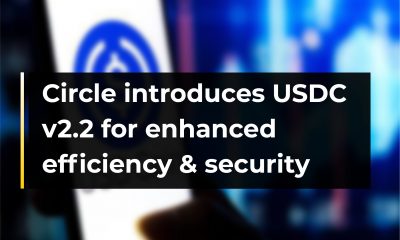Education
Subnets vs L2s: Differences & Potential of Blockchain Scaling Solutions

Blockchain technology has gained significant attention and adoption in recent years, but as its popularity grows, the need for scalable solutions becomes increasingly important. Subnets and Layer 2 scaling solutions (L2s) are two approaches that aim to address scalability challenges in blockchain networks.
In this article, we will delve into the intricacies of subnets and L2s, highlighting their differences, benefits, drawbacks, use cases, and the potential they hold for the future of blockchain scaling.
Understanding Subnets
Subnets are decentralized networks within a blockchain ecosystem that operate independently and have their own set of rules, validators, and consensus mechanisms. They are designed to enhance scalability and improve performance by enabling parallel processing of transactions and smart contracts.
In a cryptocurrency network, such as Ethereum, the main chain can become congested due to the high volume of transactions and computational demands. This congestion can lead to slower transaction processing times and increased fees. Subnets address this issue by creating additional network layers or sub-chains that can handle a subset of transactions and smart contract computations.
These subnets function as separate environments, each with its own set of validators and block producers, operating in parallel to the main chain. They can process transactions and execute smart contracts independently, relieving the congestion on the main chain and improving overall network performance.
Subnets often employ different consensus mechanisms or scaling solutions tailored to their specific needs. For example, they might use proof-of-stake (PoS) or delegated proof-of-stake (DPoS) mechanisms, sharding, or another layer 2 solution to enhance scalability and throughput. By distributing the workload across multiple subnets, the overall network capacity and efficiency can be significantly increased.
The most prominent subnets in the industry right now include:
- Avalanche Subnets: Avalanche is a blockchain platform that allows developers to create custom subnets with their own rules and token economics. Some of the most popular Avalanche subnets include the DeFi Kingdoms subnet, the Aavegotchi subnet, and the Pangolin DEX subnet.
- Cosmos SDK Subnets: The Cosmos SDK is a blockchain framework that allows developers to create custom blockchains that can be interoperable with other Cosmos-based blockchains. Some of the most popular Cosmos SDK subnets include the Binance Smart Chain subnet and the Secret Network subnet.
- Polkadot Parachains: Polkadot is a blockchain platform that allows developers to create custom parachains, which are independent blockchains that are secured by the Polkadot Relay Chain.
- Near Nightshade Shards: Near is a blockchain platform that uses a technique called sharding to scale its network. Shards are independent blockchains that are connected to the main Near blockchain. Some of the most popular Near shards include the Aurora shard and the Octopus shard.
- Fantom Opera Chains: Fantom is a blockchain platform that uses a consensus algorithm called Lachesis to achieve high throughput and low latency. Fantom supports the creation of Opera chains, which are independent blockchains that can be used for specific purposes.
Each subnet can have its own set of rules and governance mechanisms, allowing for greater flexibility in experimenting with new features, protocols, or upgrades without impacting the main chain’s stability. Additionally, these subnets can enable specialized functionalities or cater to specific use cases, fostering innovation and diversity within the blockchain ecosystem.
Understanding Layer Twos (L2s)
L2s, or Layer 2 solutions, refer to secondary protocols or frameworks built on top of existing blockchain networks. They aim to address scalability issues and improve the efficiency of blockchain systems.
L2 solutions work by processing transactions off-chain or in a more efficient manner, reducing the burden on the main blockchain network while still maintaining the security and trustlessness of the underlying blockchain.
There are various types of Layer 2 solutions, each employing different mechanisms to enhance scalability. Here are a few commonly used L2 solutions:
- Sidechains: Sidechains are independent chains that run parallel to the main blockchain but are still connected to it. They allow for faster and cheaper transactions by processing them on the sidechain instead of the main chain. Sidechains can have their consensus mechanisms, rules, and governance structures, providing flexibility for developers to optimize for specific use cases.
- State Channels: State channels enable participants to conduct multiple off-chain transactions without posting each transaction on the main blockchain. These transactions are performed privately between participants, and only the final outcome is recorded on the main chain. State channels are particularly useful for applications that require frequent interactions and microtransactions, such as gaming and instant payments.
- Plasma: Plasma is a scaling technique that creates a network of interconnected child chains, also known as plasma chains, which operate alongside the main blockchain. These child chains process transactions independently and periodically submit summarized data to the main chain, reducing the on-chain load. Plasma provides scalability by aggregating multiple transactions into a single block on the main chain, improving the overall throughput of the network.
- Rollups: Rollups are Layer 2 solutions that bundle multiple transactions together and submit a compressed version of these transactions to the main chain. There are two types of rollups: optimistic rollups and zk-rollups. Optimistic rollups rely on fraud proofs, where transactions are initially processed off-chain, and participants can challenge invalid transactions by submitting evidence on the main chain. zk-rollups, on the other hand, leverage zero-knowledge proofs to ensure the validity of transactions without requiring on-chain verification for each transaction.
These Layer 2 solutions provide different trade-offs in terms of scalability, security, and decentralization. By shifting a significant portion of transaction processing off-chain, L2 solutions can significantly increase transaction throughput, reduce fees, and improve user experience. However, it’s important to note that Layer 2 solutions may introduce additional complexities, require integration with the main chain, and involve trust assumptions depending on the specific implementation.
Currently, the most prominent L2s are zksync, starknet, optimism, and arbitrum.
Comparing Subnets and L2s
Layer 2 solutions (L2s) and subnets are both approaches used to enhance the scalability and performance of blockchain networks. However, they differ in their underlying mechanisms and the way they address scalability challenges. Here’s a comparison between L2s and subnets:
- Scalability Approach:
– L2s: Layer 2 solutions achieve scalability by processing transactions off-chain or in a more efficient manner, reducing the burden on the main blockchain. They aim to increase transaction throughput and reduce fees by leveraging techniques such as sidechains, state channels, plasma, or rollups.
– Subnets: Subnets, on the other hand, focus on partitioning the main blockchain network into smaller subnetworks or shards. Each subnet operates independently and handles a subset of the total transaction load. By dividing the workload across multiple subnets, scalability is achieved by allowing parallel processing of transactions.
- Relationship with the Main Chain:
– L2s: Layer 2 solutions are built on top of the existing main blockchain network. They rely on the main chain for security and final settlement of transactions. L2 solutions periodically submit summarized data or proofs to the main chain to ensure the integrity of off-chain transactions.
– Subnets: Subnets are separate partitions or chains that operate in parallel to the main chain. They can have their consensus mechanisms, rules, and validators. However, there is still a connection between subnets and the main chain for intercommunication, cross-chain transfers, or synchronization of certain data.
- Trade-offs:
– L2s: Layer 2 solutions often provide higher scalability and faster transaction processing compared to the main chain. However, they may introduce additional complexities, require integration with the main chain, and involve trust assumptions depending on the specific implementation.
– Subnets: Subnets offer scalability by allowing parallel processing across multiple chains, but they may introduce challenges related to cross-chain communication, consensus synchronization, and maintaining security across subnets.
- Use Cases:
– L2s: L2 solutions primarily focus on enhancing the scalability and cost-efficiency of blockchain applications. L2 solutions operate as an additional layer on top of the main chain and aim to increase transaction throughput and reduce fees. They achieve this by conducting off-chain processing or utilizing alternative consensus mechanisms. L2 solutions are particularly beneficial for applications that require high transaction throughput and low fees, such as decentralized finance (DeFi) platforms, gaming, and micropayments. By leveraging L2 solutions, these applications can achieve faster and cheaper transactions without compromising the security and decentralization provided by the underlying main chain.
– Subnets: Subnets are designed to address scalability and performance challenges in a different way. Subnets are essentially separate and independent chains within a blockchain network. They allow the network to handle a massive number of transactions or support a diverse set of applications with varying performance requirements. Subnets enable horizontal scalability by distributing the workload across multiple chains, thus improving overall network capacity. With subnets, different parts of the network can operate with their own consensus mechanisms, governance structures, and performance characteristics. This makes subnets well-suited for scenarios where there is a need to handle a large volume of transactions or support various applications simultaneously.
Subnets and L2s: Benefits and Drawbacks
Let’s explore the benefits and drawbacks of subnets and L2s.
Benefits of Subnets:
- Scalability: Subnets enable horizontal scalability by partitioning the blockchain network into smaller subnetworks or shards. This allows for parallel processing of transactions, significantly increasing the network’s overall transaction throughput.
- Flexibility: Subnets provide the flexibility to tailor specific subnetworks to different use cases or applications. Each subnet can have its own consensus mechanism, rules, and validators, allowing for customization and optimization based on the requirements of the applications running on that subnet.
- Enhanced Performance: With parallel processing, subnets can handle a larger number of transactions simultaneously, leading to improved transaction confirmation times and lower latency. This makes subnets suitable for high-demand applications and scenarios where real-time transaction processing is crucial.
- Increased Network Capacity: By distributing the transaction load across multiple subnets, the network’s capacity to handle a large volume of transactions is expanded, reducing congestion and potential bottlenecks.
Drawbacks of Subnets:
- Cross-Subnet Communication: Intercommunication between subnets can be complex, requiring additional mechanisms for data exchange (e.g. Message Passing, Cross-Subnet APIs, Atomic Swaps), consensus synchronization, and cross-chain transfers. Ensuring seamless interaction and interoperability across subnets may pose technical challenges.
An example scenario of subnet intercommunication could be a blockchain network with separate subnets for different industries or use cases, such as finance, supply chain, and healthcare. These subnets might require sharing data or assets across their boundaries. Achieving seamless interaction would involve developing protocols for secure data exchange, implementing cross-chain transfer mechanisms to enable asset interoperability, and ensuring consensus synchronization to maintain network integrity. This just involves a tonne of work and opens the subnet to more potential security problems.
- Security Considerations: The security of subnets relies on the individual consensus mechanisms and validators within each subnet. Maintaining security across all subnets and preventing potential attacks or vulnerabilities can be complex.
- Decentralization Trade-offs: Depending on the design, subnets may introduce a trade-off between scalability and decentralization. As the number of subnets increases, the number of validators required for each subnet may decrease, potentially leading to a concentration of power in the hands of a few validators.
Benefits of L2s:
- Increased Scalability: L2 solutions alleviate the burden on the main blockchain by processing transactions off-chain or in a more efficient manner. This results in higher scalability, allowing for a larger number of transactions to be processed quickly and at lower costs.
- Cost Efficiency: L2 solutions can significantly reduce transaction fees by processing transactions off-chain or aggregating multiple transactions into a single on-chain transaction. This makes blockchain-based applications more cost-effective, particularly for use cases that involve frequent and small-value transactions.
- Faster Transaction Confirmation: By reducing the reliance on the main chain, L2s enable faster transaction confirmations, improving the overall user experience and enabling near-instantaneous transaction finality.
- Compatibility and Interoperability: L2 solutions can be designed to be compatible with existing blockchain infrastructure, allowing seamless integration with various decentralized applications (DApps) and protocols. This promotes interoperability and facilitates the adoption of L2 solutions within the broader blockchain ecosystem.
Drawbacks of L2s:
- Security Trade-offs: Depending on the specific implementation, L2 solutions may introduce security trade-offs. Off-chain processing or relying on external entities for transaction verification may require trust assumptions and can potentially introduce new attack vectors or vulnerabilities. Suppose we have a blockchain-based payment system that aims to increase scalability by adopting an L2 solution known as a payment channel network. In this network, users can open payment channels with each other, allowing for faster and cheaper off-chain transactions. The final settlement of these transactions is recorded on the main chain.
One security trade-off that arises with this L2 solution is the need to trust the payment channel participants. As transactions occur off-chain, participants need to trust that their counterparties will honour the agreed-upon balances and not attempt to cheat.
For example, let’s say Alice and Bob open a payment channel, and Alice initiates multiple transactions with Bob, updating the channel’s balance. However, Bob decides to broadcast an older channel state to the main chain, attempting to revert the state and claim more funds than he is entitled to. This is known as a “channel state attack.”
In this scenario, if Alice is not continuously monitoring the network and fails to respond with the correct, updated channel state, she may lose funds. This attack vector is introduced due to the reliance on off-chain processing and the trust assumptions associated with the payment channel participants.
- Integration Complexity: Implementing and integrating L2 solutions with the main chain can be complex and require modifications to existing smart contracts or infrastructure. Ensuring compatibility and smooth interaction between the L2 and the main chain may pose technical challenges. This is because smart contracts need to be designed to support the interoperability and communication between the L2 and the main chain. This can involve rewriting parts of the contract logic or introducing additional functions to handle L2-specific operations.
- Limited Applicability: L2 solutions may not be suitable for all types of blockchain applications. Certain use cases, such as those involving complex smart contract interactions or requirements for absolute on-chain transparency, may not be well-suited for L2 solutions. The reason is that L2 solutions typically involve off-chain processing or consensus mechanisms that allow for faster and cheaper transactions, but they may sacrifice some level of on-chain transparency and security.
Conclusion
The choice between subnets and Layer 2 (L2) networks depends on the specific needs of an application. For applications that prioritize high security and decentralization, subnets may be more suitable. On the other hand, applications that emphasize low latency and high throughput might prefer L2 networks. It is important to carefully consider these factors when deciding which option to choose, as they can significantly impact the performance and functionality of the application.

























2 Comments